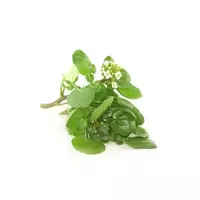Gerucha medicinal

The perennial herbaceous plant is medicinal or common in the Cabbage family and grows mainly in water, so there is another name for the plant, which sounds like a water watercress. Cress is a fairly well-known type of green salad that has several varieties. For example, watercress, capuchin watercress, garden, bitter and meadow watercress, as well as water watercress or medicine bellows. Water watercress or bellows grow over a fairly wide area from Europe to Central Asia. A medicinal geruch has long been used as a salad, as well as a spice.
The leaves of water watercress enjoy well-deserved popularity in cooking, as a healthy and tasty vegetable. The common germ consists of a thick stem that reaches 60 cm in length. The leaves of the water watercress are oval-shaped. The vent blooms with small white flowers. The fruits of the plant are an elongated pod with flattened seeds. In addition to the cultivated species of the germ plant or Nasturtium officinale, wild varieties of water watercress are also found, which are native to Algeria, Morocco, Libya, Egypt, the Canary Islands, Europe and Asia.
The common germ is harvested in the natural habitat of the plant or grown from seeds and petioles in the infield. Water watercress or medicine bellows refers to healthy and dietary foods. What is most eloquently indicated by the chemical composition of the medicinal fountain, which is enriched with a sufficient amount of vitamins and minerals. The benefit of the fountain of medicinal or water watercress lies in the high content of minerals such as potassium, iron and phosphorus, in addition, salad foxes contain vitamins of group A, C, E, K, as well as B.
Fountain seeds are also used to produce natural oils that are enriched with oleic, palmitic, linolenic and other essential acids. The useful properties of a fountain or water watercress have long been actively used not only in cooking, but also in medicine. Common germ is considered an excellent preventive and therapeutic remedy for diseases of the circulatory system. Also, water watercress is able to naturally cleanse blood and remove harmful compounds from the body. In folk medicine, the useful qualities of the plant have long been used, which helps with fevers and scurvy.
Decoctions and infusions from a medicinal fountain are used for diseases of the nervous system, thyroid gland, anemia, rheumatism, diabetes mellitus. The leaves of a fountain or water watercress began to be used as food by the inhabitants of Ancient Rome. At the same time, the Romans began to dry the leaves of the fountain and make spice. Currently, both green leaves of water watercress and dried spice are eaten in the well.
The distinctive taste and aroma of the bellows are used not only in salads, but also in soups, as well as in vegetable and meat dishes. A sharp and pronounced aroma similar to horseradish combined with the tart and distinctive taste of water watercress is great for fish dishes. The vent is usually mixed with rosemary and mint leaves. The resulting spice mixture is used in many Asian and European dishes.
32 kKal Medicinal Well
The energy value of the medicinal fountain (Ratio of proteins, fats, carbohydrates - ju):
Proteins: 2.6 g (~ 10 kCal)
Fats: 0.7 g (~ 6 kCal)
Carbohydrates: 4.4 g (~ 18 kCal)
Energy ratio (bj | y): 33% | 20% | 55%
 Español
Español Français
Français Português
Português Русский
Русский 简体中文
简体中文 繁體中文
繁體中文 日本語
日本語 한국어
한국어 العربية
العربية Türkçe
Türkçe Қазақ
Қазақ Deutsch
Deutsch Italiano
Italiano Українська
Українська
